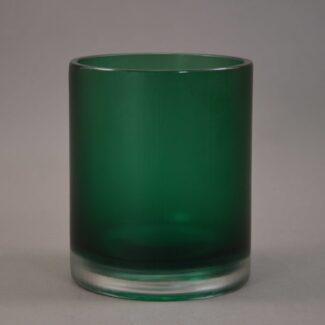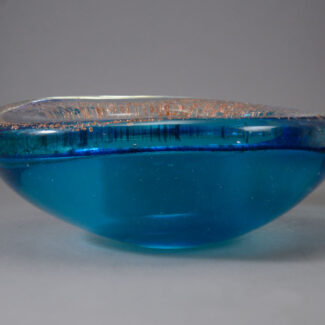Venini & Co. (Murano, Est. 1921)
Carlo Scarpa (Italian, 1906-1978)
‘Corrosi’ Vase no. 4112, c. 1936
corroso, sommerso, blown glass
4 5/8” high x 5 1/16” diameter
Notes: From the ‘Corrosi’ line of vessels designed and made by Carlo Scarpa in association with Venini & Co. in the 1930’s, this diminutive ‘V’ form vase no. 4112 is executed with blue /green sommerso glass and finished with an outer corroso texture and all-over iridized finish. Reminiscent of a rhino horn cup in form the style is a thoroughly modern expression creating a continuity through time and space, material and technique. A parallel vase, in champagne, resides in the collection of The Met (2014.208.32), see Reference below for the official description.
Markings: ‘venini / Murano / MADE IN / ITALY’ c. 1935-1966
Condition: Vintage, Excellent
For Accuracy: insignificant wear, as expected on any vintage vase. See Photographs.
Reference:
The Metropolitan Museum of Art. Venini & Co, Carlo Scarpa, Corrosi, no. 4112. Acc. No. 2014.208.32
“Between 1932 and 1947, Carlo Scarpa worked closely with Paolo Venini and other master glassblowers to pioneer techniques, silhouettes, and colors that thoroughly modernized the ancient traditions of the glass-making Venetian island Murano. New methods of surface decoration were invented and each vessel is named for the techniques employed in their making, emphasizing the fact that experimentation was crucial to producing such a dazzling array of visual and material effects.”
“Meaning corroded, corrosi is a cold working technique that uses hydrofluoric and sulphuric acid in solution to give the glass an irregular surface texture. Changes in temperature, the amount of time the glass is exposed to the acid bath, and the composition of chemical agents can lead to a variety of effects. Areas of the glass that are to be kept smooth and bright can be covered with wax or paraffin prior to submersion. Ultimately, this method yields an inconsistent surface texture that both diffuses and reflects light for a fluctuating, iridescent effect. This piece, which is quite modernist in its tapered “V” form, is given a sense of age and handling through the corrosi technique.”
Italian Glass, Murano / Milan, 1930-1970. Prestel. Venini & C., Murano, ‘Catalogo Blu,’ designs by Carlo Scarpa, 1936, pp.19

















